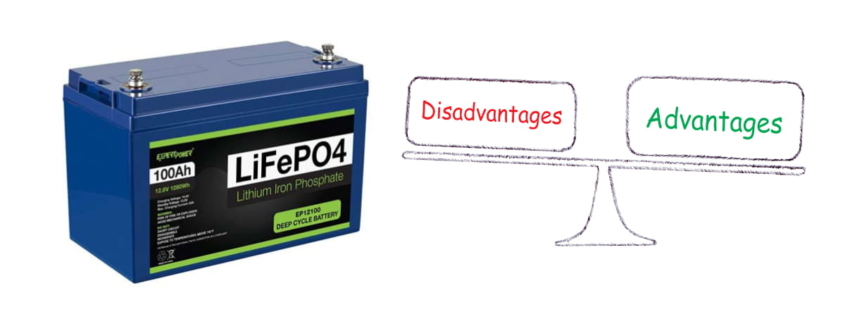Advantages and disadvantages of lifepo4 battery
In this article, we will look at the advantages and disadvantages of using LiFePO4 batteries and how they compare to other lithium-ion battery technology.

What are the lifepo4 battery advantages and disadvantages?
Lithium Iron Phosphate (LiFePO4) batteries offer many advantages over other types of batteries. First, they have a much longer life span than most other types of batteries. They also have a high energy density and lighter weight, making them easier to transport and use in portable applications. The main disadvantage of LiFePO4 batteries is their cost.
Let’s analyze it in detail:
Advantages of LiFePO4 Battery
Longer lifespan compared to lead-acid batteries
One of the main advantages of lithium iron phosphate batteries is the longer cycle life compared to lead-acid batteries. LiFePO4 batteries have a cycle life of 1,000 to 3,000 cycles, while similarly sized lead-acid batteries range from 250-750 cycles. This means LiFePO4 batteries can be used more frequently and for more extended periods without needing to be replaced.
Additionally, LiFePO4 batteries deliver a constant power output throughout the discharge cycle. In contrast, lead-acid batteries tend to provide less power over time. This makes LiFePO4 batteries a more reliable option for powering devices that require continuous power delivery.
Higher energy density, making them ideal for space-limited applications
LiFePO4 (lithium iron phosphate) batteries have a higher energy density than other battery types, making them ideal for space-limited applications. The high energy density of LiFePO4 batteries means they can store much more energy in a small space compared to other battery technologies.
This makes them perfect for electric vehicles, where efficient storage and lightweight components are essential. In addition, LiFePO4 batteries offer excellent performance in extreme temperatures and can handle many charge cycles before needing to be replaced. This makes them great for use in solar applications or areas with frequent power outages, as they often don’t need to be replaced.
Improved performance in cold temperatures
At 0°C, a lead-acid battery would deliver only 20-30% of its rated capacity, while a LiFePO4 battery can still output up to 70%. The chemical reactions inside LiFePO4 batteries are much less affected by cold temperatures than lead-acid batteries. Cold temperatures slow down the chemical reactions inside batteries, hampering their performance and reducing their discharge rate. These batteries can still deliver power even when the temperature drops to 0°C.
This means that the battery can use some energy to power an external or internal heater, making them ideal for use in colder climates. On the other hand, LiFePO4 batteries also perform better in hot environments, as the increased chemical reactions can result in overperforming.
More excellent safety due to lack of toxic materials
LiFePO4 batteries have excellent safety due to the lack of toxic materials over other battery systems. These are thermally and chemically stable, making them safer than lead-acid batteries. They are incombustible and can withstand high temperatures, resulting in improved discharge and charge characteristics. LiFePO4 batteries also have a higher energy density than lead-acid batteries, allowing them to store more energy per unit of material.
They are better for the environment as they can be recycled.
LiFePO4 batteries are also more cost-efficient than other lithium-ion batteries, making them the preferred choice for portable electronics. Moreover, they are recyclable, helping to reduce the metals in landfill and incinerator facilities.
Disadvantages of LiFePO4 Battery
Higher initial cost
One of the main disadvantages of LiFePO4 batteries is their higher initial cost when compared with traditional lead-acid cells. The price difference between LiFePO4 and lead-acid can be significant; depending on the application, it could add up to several hundred dollars extra for a single battery pack. This additional expense can be challenging to justify in applications with tight budgets or when buying multiple batteries simultaneously. Moreover, installation services can further increase total costs considerably if required.
A limited number of charge cycles before degradation
LiFePO4 batteries have several advantages, including a long cycle life of up to 4000 charge-discharge cycles and excellent chemical stability. However, they have their drawbacks. LiFePO4 batteries can experience degradation if exposed to extreme environmental conditions, such as high temperatures or low charge states. This can reduce their lifespan, limiting the number of charge cycles before degradation or even failure.
Requires a battery management system
LiFePO4 batteries require a battery management system (BMS). This system is designed to monitor and control the cells to ensure their longevity and safety and provide a way for them to be recharged. The installation of a BMS is expensive, and it also requires significant expertise to install correctly. In addition, many systems require that the cells be monitored regularly to maintain optimal performance. Without regular maintenance, premature aging and reduced performance can occur, leading to shorter lifespans for the battery cells.
Less available in the market
Lithium Iron Phosphate (LiFePO4) batteries are less available in the market than other lithium-ion batteries. One main disadvantage is that they have a lower energy density than other lithium-ion batteries, making them unsuitable for wearable devices like watches. Additionally, LiFePO4 cells are hefty and much less energy dense than other li-ion cells, meaning that battery manufacturers may opt for cheaper alternatives.
In conclusion
The lithium iron phosphate (LiFePO4) battery has some advantages, such as a long lifespan, high energy density, improved safety, and good for the environment. However, some drawbacks are associated with this type of battery, including its high initial cost, the limited number of charge cycles before degradation, the requirement for a battery management system, and less availability in the market. Ultimately, it is up to the individual to decide what type of battery best meets their needs and fits their budget.
When deciding whether LiFePO4 batteries are the right choice, it is essential to consider specific needs and budgets. The voltage, cost, safety, and compatibility should all be considered. For example, if someone is looking for a battery for a small home solar system, then LiFePO4 batteries may be the right choice. They are often less expensive and can provide the necessary power requirements. NiMH or Li-ion batteries may be a better option if a higher voltage is needed.








